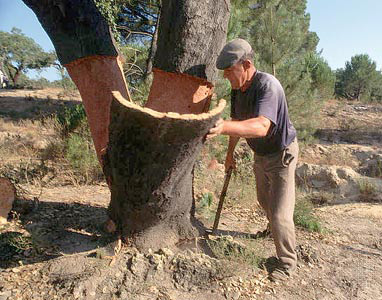Wednesday, June 19 2013
Corks Gone Screwy
 Cork trees are closely related to bananas. True story.
Cork trees are closely related to bananas. True story.
Putting a cork in it has a long and storied history: corks provided the ideal closure for bottles and barrels for twenty centuries, and the argument still exists that there is nothing better than a chunk of tree bark for keeping quality wine in good condition.
However, in the early 20th century cork manufacturers in Portugal were nationalised, with the government handing over complex industrial and distribution systems to their cronies and useless brothers-in-law. Only a few companies managed to keep continuity, to keep producing quality corks, but they were overwhelmed the bumblers who produced volumes of second-rate TCA ('corked-aroma') closures for years.
Things have gotten better--enormously better, with good industrial controls and manufacturing practices, and protocols that have reduced TCA from unacceptable levels of a few decades ago to a minor manufacturing issue today. But in that time period of bad cork, other closures made progress. While the first plastic corks were about as appealing as ground-up hockey pucks, and the first screw-caps left wine unaged and rather unlovely, they made a lot of progress, and today are considered strong alternatives to natural (die-cut) or manufactured (agglomerated) cork products.
In order to offer some of the convenience of screw caps while still using the romantic (and sustainable) raw material of cork, Amorim (full disclosure: they're friends of mine, and fine folks to boot) have come up with a new type of closure, the Helix. According to Drinks Business, it was a collaboration between an American manufacturer and the Amrorim group that came up with a T-shaped stopper that's held in place inside the bottle by a very long screw-thread, resembling most closely the rifling on the inside of a gun barrel.
 Photo: Drinks Business
Photo: Drinks Business
Agglomerated T-stopper corks aren't new: they've been around for many years. The real changer is the bottle, which has the raised thread on the inside of the neck, allowing the cork to grip tightly, yet pull loose with a moderate amount of twisting. For a wine designed to be used in the short term, it's a pretty great idea--ugly, to be sure, but I'm usually most interested on what's inside the bottle, as long as I can get it open and the cork isn't tainted.
Here's a short video from Tom Cannavan, a British wine writer who got his mitts on one of the early release bottles.
Pretty interesting stuff, but strictly for the commercial industry rather than for those of us who make wine at home--first off, those are proprietary bottles, so you'd be locked into using them forever, and buying them from the manufacturer, and second, I haven't seen the machine that inserts those corks, but I don't imagine it's within purchase reach of the average home winemaker.
We can keep watching though: it may eventually filter down to us over time.
| Posted by Mr. Helix AT 5:53PM | 0 Comments | Post A Comment |

